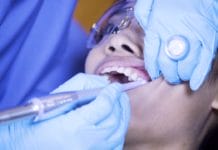Since the shut down over COVID-19, the dental world as we know it has changed, and teledentistry has become an industry buzz word. Although offices were closed, the need for emergency treatment did not stop. The time to already have a teledentistry platform in place had passed.
Unfortunately, many offices fell short of this much-needed tool when they didn’t have the appropriate technology in place. In fact, many offices had never heard of teledentistry, let alone how beneficial it could be to a practice. Interestingly, teledentistry would prove to be a great asset during this unprecedented time and almost necessary moving forward.
My recent telehealth appointments gave me exposure to what we were overlooking in the dental industry. My appointments were easy, less expensive, and convenient. I simply spoke with my doctor through a live video. All tests were ordered, and prescriptions sent to the pharmacy. After the telehealth visit, I was called back to make my next appointment. This easily saved me two hours.
Through this experience, I thought about how teledentistry could benefit patients and how hygienists could be an asset. What could we do that would translate into production, build our value for the practice, and assist our patients? I needed more information and a better understanding of teledentistry.
The Birth of Teledentistry
According to Jampani, N.D., et al. “Applications of teledentistry: A Literature Review and Update.” in the Journal of International Society of Preventive & Community Dentistry, initially teledentistry was presented in 1989, as a concept for dental informatics.
From there, in 1994, the United States Army utilized this information on a large scale in the U.S. Army Total Dental Access Project. The military wanted to reach as many people as possible by extending services to distant and rural areas, decreasing patient costs, and providing a more comprehensive analysis of information.1
Then, in 1997, teledentistry was defined by Cook as, “… the practice of using video-conferencing technologies to diagnose and provide advice about treatment over a distance.”1
In 2015, the American Dental Association (ADA) adopted its policy regarding teledentistry. To summarize, “Telehealth refers to a broad variety of technologies and tactics to deliver virtual medical, health, and education services.”2 This allows us as licensed dental hygienists the ability to use teledentistry to assist with our office practices under the scope of the ADA and state regulations as well as a dentist.
ADA Policy
The ADA has several requirements for teledentistry. The summary of what I learned from the ADA website is that providers must hold a license or be credentialed in the state or authorized by the state dental board where the patient resides. Provider recommendations can be made by phone, video, email, or text. For emergencies, referrals, and consultations, dentists must be available to the other, providing clinicians.
Also, due to HIPAA regulations, confidential patient information must travel via a secured network. It is important to consult state guidelines to stay within the scope of practice while using teledentistry. Patients must also be informed of the modality of care, costs associated, and who the provider will be. The patients must be active participants in the communication, and all records should be kept, per state law, the same as if they were being seen in an office.
Complete records must be readily available for the patient’s home dental office and to them as a summary of services. Interestingly, the ADA “opposes a single national federalized system of dental licensure for…teledentistry.”2 More extensive information can be found on the ADA website regarding policies, reimbursement codes, technical recommendations for secure networks, supervision of staff, and different companies that offer platforms.
Teledentistry Vehicles
As identified by the ADA, there are four communication vehicles currently available for teledentistry. Live (synchronous), store-and-forward (asynchronous), remote patient monitoring (RPM), and mobile health (Mhealth) all use different approaches.
With live (synchronous) communication, the provider and patient can use a video conference and speak to one another in real-time. This approach is comparable to using Zoom or Facetime.
Store-and-forward (asynchronous) allows the patient to record a video and send it to the practitioner. The team member can respond likewise and record and send a video to the patient at a time that is convenient for the practitioner.
Remote patient monitoring (RPM) is conducted through a secure network where patients and staff can send sensitive personal information back and forth. Think radiographs, medication lists, prescriptions, lab results. This is used in telehealth as well as teledentistry in large corporations as well as smaller ones. This type of communication can be linked to several physicians, hospitals, and specialists. It allows the information to be passed back and forth using one vehicle for all providers, and one place for the patient to access information.
Lastly, The ADA defines Mobile Health (Mhealth) as, “Health care and public health practice and education supported by mobile communication devices such as cell phones, tablet computers, and personal digital assistants (PDA).”2 This communication vehicle has been widely used during COVID-19 as we attempt to connect remotely with patients.
Utilization of Dental Hygienists
Now that we have a summary of ADA policy and communication vehicles, it begs the question, are hygienists being utilized to the full extent of their abilities? I’m not convinced they are, and here is why. Considering the backlog of established patients and the rally to obtain new patients, our chair time is more precious than ever.
We can streamline the nonclinical aspects of an appointment through teledentistry before treating hands-on operative needs. This approach decreases chair time and increases our profitability. However, I am not hearing of many offices doing this, let alone utilizing the hygienist.
First, a great relationship built on trust and open communication is foundational for the hygienist and the dentist to have a mutual understanding regarding how teledentistry procedures are to be conducted. From here, there are several avenues hygienists can be utilized.
As hygienists, we have extensive educational backgrounds and vast knowledge of dental procedures. We are front and center for dental exams and have explained to numerous patients their treatment needs. We also answer the same questions patients have, over and over. We build and establish relationships. Simply, patients trust us because of the bond we build. All of this experience makes us a valuable asset.
How Communications Could Work
While nurturing our existing client relationships, teledentistry grants us the possibility to increase our worth and continue to be profitable for our practice by offering virtual consults with store-and-forward practice introductions. When a new patient finds the practice online through any number of social media platforms, such as Facebook, Twitter, and Instagram, they are redirected to the practice website.
Once the teledentistry link on the practice home page is opened, they will be redirected to store-and-forward videos such as a greeting for new patients, new patient appointment procedures, managing patient expectations, as well generalized treatment procedures such as non-surgical periodontal thereapy/SRP, crown and bridge, extractions, etc. New patients then have the option to send in a video of their concerns, needs, and questions before an appointment.
After review, the practitioner can address the patient and give preliminary treatment recommendations. Individual patient concerns can be addressed with a personalized greeting video and a brief synopsis of recommendations while also attaching store-and-forward videos with more in-depth procedural information. This allows the patient to form questions they may want to ask prior to their first appointment. Patients are informed that recommendations are preliminary, and a diagnosis will be determined after a thorough clinical exam, radiographs, and full periodontal charting.
Office contact information is also available if patients are more comfortable speaking with someone in person.
Patients are then assigned a patient advocate, and all scheduling and financials can be discussed. When using teledentistry, the patient’s questions can be answered, new patient paperwork completed, and finances secured. Staff time usually spent on the phone with new patients will be greatly reduced during peak hours if patients use the platform, and staff can respond at a dedicated, more convenient time.
We can now effectively combine the new patient’s comprehensive exam with immediate treatment while reducing the need for lengthy, in-depth appointments that prove to be fruitless due to lack of finances or time scheduled. We will also be reducing the amount of time a patient must dedicate for a trip to the office. Instead of several appointments and time spent discussing finances and treatment recommendations in person, once a patient arrives at the office, they will have a basis of knowledge on the proposed treatment recommendations and be financially prepared to start treatment that same day. This will reduce active chair time and increase profitability.
Anything you discuss with your patients during the hygiene appointment can be discussed over teledentistry. Think about how easy it would be to send the patient a video on SRP, new patient appointments, crown and bridge, and extraction expectations. The list is endless! Hygienists are more than qualified to provide this information.
Patients are comforted by seeing a friendly face they will meet or someone they are already familiar with and trust. Videos of home care techniques, post-operative pictures of healing, and questions patients may have before their new patient appointment can be addressed by a trusted and knowledgeable practitioner.
This builds confidence in the practice and you as a practitioner. We all know when patients have confidence in their dental home, they tell their family members and friends. This, in turn, translates into referrals and new patients for the practice. So do it! Have that conversation with your dentist. Explain to them how the practice can benefit through the use of teledentistry and, more importantly, how you are an integral part of building trust with patients and profitability through communication. You are a dental hygienist. You D.O. have a pivotal role. I have faith in you!
Now Listen to the Today’s RDH Dental Hygiene Podcast Below:
References
- Jampani, N.D., et al. Applications of Teledentistry: A Literature Review and Update. Journal of International Society of Preventive & Community Dentistry. 2011; 1(2): 37-44. Retrieved from www.ncbi.nlm.nih.gov/pmc/articles/PMC3894070/
- ADA Policy on Teledentistry. American Dental Association. Policy adopted in 2015. Retrieved from https://www.ada.org/en/about-the-ada/ada-positions-policies-and-statements/statement-on-teledentistry
- Pennic, F. The Rise of Teledentistry: Benefits, Use Cases & Adoption Challenges. Healthcare I.T. News. 5 May 2020. Retrieved from https://hitconsultant.net/2020/05/04/teledentistry/#.XufA-0VKiUm











